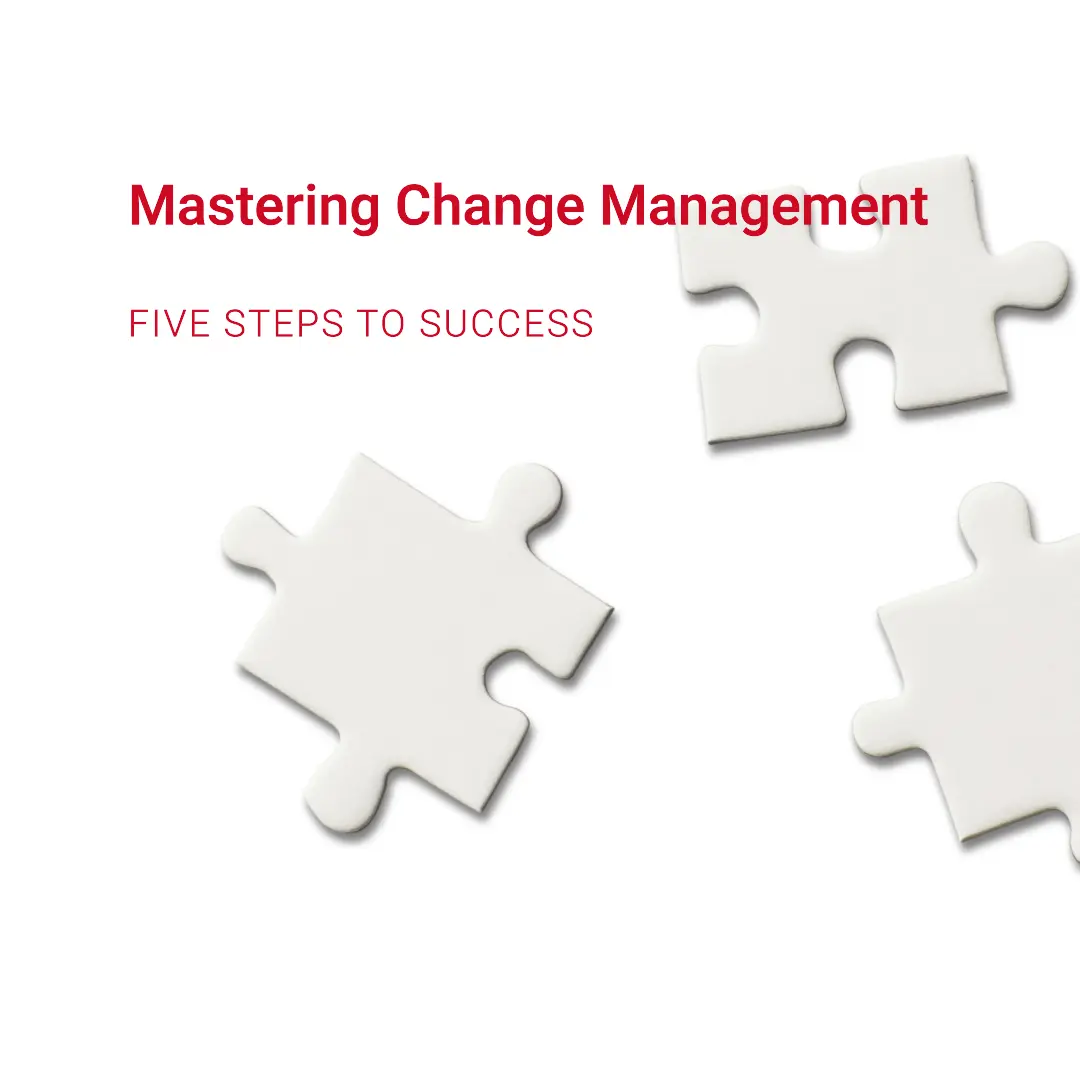I. Introduction
Change is inevitable, and in today’s fast-paced business world, it’s more important than ever to embrace it. Whether it’s adapting to new technologies, shifting market demands, or reimagining organizational structures, change can be the key to staying competitive and thriving in the long run. However, managing change effectively can be challenging, and that’s where the art of change management comes into play.
Hi there! I’m glad you’ve joined me on this journey to explore the world of change management. As someone who has experienced the ups and downs of change in various organizations, I can attest to the importance of having a solid strategy in place. Change management can make or break a company’s ability to evolve and succeed, so it’s crucial to master the process.
In this blog post, I’ll be sharing with you the five essential steps of change management. These steps have been tried and tested by countless organizations, and they can provide a reliable roadmap for navigating the complexities of change. By understanding and applying these steps, you can guide your organization through any change, big or small, and set it up for long-term success.
So, buckle up and get ready to become a change management maestro! Let’s dive into the five essential steps that will help you transform your organization for the better.
II. Step 1: Assessing the Need for Change
Before embarking on any change journey, it’s essential to have a clear understanding of why the change is needed in the first place. Trust me, I’ve seen far too many companies jump into change initiatives without a solid grasp of the underlying issues, only to end up in a worse place than where they started. To avoid such pitfalls, let’s talk about how to properly assess the need for change.
A. Identifying pain points and potential benefits
Start by taking a good, hard look at your organization’s current state. Are there any pain points or bottlenecks that are hindering growth or efficiency? It could be outdated technology, inefficient processes, or even communication breakdowns between departments. Also, consider the potential benefits that the change could bring, such as increased revenue, enhanced customer satisfaction, or improved employee morale.
For instance, I once worked with a company that was struggling to keep up with customer support requests. They identified their legacy ticketing system as a major pain point, and realized that upgrading to a modern solution would significantly improve their response times and customer satisfaction.
B. Gathering feedback and data
You don’t have to go it alone when assessing the need for change. In fact, it’s crucial to involve others in the process to get a more accurate and holistic view. Collect feedback from employees, customers, and other stakeholders to understand their perspectives on the issues at hand. Additionally, gather data to support your assessment, such as sales figures, customer satisfaction ratings, or employee retention rates.
C. Conducting a gap analysis
Once you’ve identified the pain points and gathered feedback, it’s time to conduct a gap analysis. This involves comparing your organization’s current state to its desired future state and determining the steps needed to bridge the gap. By clearly outlining the differences between where you are and where you want to be, you can build a strong case for change and establish a clear direction for your change management efforts.
D. Example: Company X identifying the need for digital transformation
Let me share a real-life example. Company X, a traditional brick-and-mortar retailer, was struggling to keep up with the surge in e-commerce. They conducted a thorough assessment and identified the need for a digital transformation to enhance their online presence and stay competitive. By recognizing the pain points and potential benefits, gathering feedback, and conducting a gap analysis, they were able to create a compelling vision for change and kickstart their digital journey.
Remember, a well-planned change initiative starts with a solid understanding of why the change is needed. By carefully assessing the need for change, you’ll be well on your way to a successful transformation that benefits your organization and all of its stakeholders.
III. Step 2: Building a Change Management Team
Now that you’ve identified the need for change and have a clear vision of the desired outcome, it’s time to assemble a team of superheroes (or, well, a change management team) to help guide your organization through the transformation. In my experience, having a dedicated team of diverse individuals is crucial for success, as it ensures a range of perspectives and skills are brought to the table.
A. Assembling a diverse group of stakeholders
When putting together your change management team, look for individuals who represent different areas of the organization, from frontline employees to upper management. This diversity will help ensure that all perspectives are considered, and it’ll also foster buy-in from the broader organization as people see their interests represented on the team.
B. Establishing clear roles and responsibilities
As with any team, it’s important to establish clear roles and responsibilities from the get-go. This not only helps avoid confusion and duplication of efforts, but it also ensures that each team member is accountable for their part in the change process. Some common roles in a change management team include the change sponsor, who champions the change at the executive level; the change manager, who oversees the day-to-day implementation; and the change agents, who help communicate and support the change across the organization.
C. Importance of effective communication and collaboration
I cannot stress enough the importance of effective communication and collaboration within the change management team. You’re all in this together, and the more openly and honestly you communicate with each other, the smoother the journey will be. Regular team meetings, updates, and brainstorming sessions are essential to keep everyone on the same page and working toward the same goals.
D. Example: How Company Y formed their successful change management team
Let me tell you about Company Y, which faced the challenge of consolidating multiple business units into one unified organization. They understood the importance of having a strong change management team, so they carefully selected representatives from each business unit, as well as individuals with expertise in areas like HR, IT, and finance. This diverse team worked together seamlessly, with clear roles and open communication, ultimately guiding the company through a successful and efficient consolidation process.
By assembling a dedicated and diverse change management team, you’ll be well-equipped to navigate the complexities of change and lead your organization toward a successful transformation. Remember, teamwork makes the dream work!
IV. Step 3: Developing a Change Management Plan
With your stellar change management team in place, it’s time to put your heads together and create a comprehensive plan to guide your organization through the upcoming transformation. Think of this plan as your trusty roadmap, designed to keep everyone on track and moving in the right direction. I’ve seen firsthand how having a well-thought-out plan can make all the difference between a smooth transition and a chaotic one, so let’s dive into the key elements of a successful change management plan.
A. Setting goals and objectives
Begin by outlining the specific goals and objectives of your change initiative. These should be clear, measurable, and aligned with your organization’s overall strategy. Remember, your goals will serve as the guiding light throughout the change process, so make sure they’re well-defined and achievable. For instance, if your objective is to improve customer satisfaction, you might set a goal of reducing response times by 50% within six months.
B. Identifying risks and mitigation strategies
Change can be risky, but by proactively identifying potential risks and devising strategies to mitigate them, you can significantly reduce the chances of encountering roadblocks along the way. Work with your change management team to brainstorm potential risks, such as employee resistance, budget constraints, or unforeseen technical issues. Then, develop contingency plans to address these risks, should they arise.
C. Establishing a timeline and milestones
A change management plan is not complete without a clear timeline and milestones to mark progress. Develop a realistic timeline that takes into account the various stages of the change process, as well as any dependencies between tasks. Break the timeline into smaller, manageable milestones, and celebrate these mini victories as they’re achieved. This not only helps maintain momentum but also boosts morale throughout the organization.
D. Example: Company Z’s comprehensive change management plan
Let me share the story of Company Z, which embarked on a major shift in its business model to focus on sustainability. They developed a detailed change management plan that included clear goals (such as reducing their carbon footprint by 25% within two years), identified potential risks (like supplier disruptions), and established a timeline with milestones to mark their progress. This meticulous planning paid off, and Company Z successfully transitioned to a greener, more sustainable business model with minimal disruptions.
By developing a comprehensive change management plan, you’ll provide your organization with the guidance and structure needed to navigate the often-turbulent waters of change. Remember, a well-planned change initiative is much more likely to succeed, so invest the time and effort to create a solid roadmap for your transformation journey.
V. Step 4: Communicating and Implementing the Change
You’ve assessed the need for change, built an amazing change management team, and developed a comprehensive plan to guide your organization through the transformation. Now comes the exciting part: actually implementing the change! This stage can be both exhilarating and nerve-wracking, but with effective communication and some persistence, you can bring your vision to life. Let’s explore how to communicate and implement change like a pro.
A. Tailoring communication to different stakeholder groups
When it comes to communicating change, one size does not fit all. Different stakeholder groups will have unique concerns and interests, so it’s important to tailor your messaging accordingly. For example, while executives might be focused on the financial impact of the change, frontline employees may be more concerned about how it will affect their daily tasks. By addressing the specific needs and concerns of each group, you’ll increase buy-in and create a smoother transition.
B. Overcoming resistance to change
Resistance to change is a natural human response, but it can be a significant obstacle if not addressed properly. To overcome resistance, involve stakeholders early in the process, listen to their concerns, and provide clear explanations of why the change is necessary and how it will benefit them in the long run. You may also consider offering training and support to help employees adapt to new processes or technologies.
C. Monitoring progress and adjusting the plan as needed
As with any journey, there may be detours and unexpected obstacles along the way. Regularly monitor your progress against your change management plan, and be prepared to make adjustments as needed. This may involve revising your timeline, reallocating resources, or even reevaluating your goals. Remember, flexibility is key when navigating change, so stay open to learning and adapting as you go.
D. Example: How Company A successfully rolled out their new software platform
Allow me to share the inspiring story of Company A, which needed to transition its entire workforce to a new software platform. They understood the importance of clear communication and tailored their messaging to different stakeholder groups, from IT specialists to customer service representatives. They also provided ample training and support to help employees overcome their resistance and adapt to the new system. By closely monitoring their progress and making adjustments along the way, Company A successfully implemented the software platform with minimal disruption to their operations.
As you embark on the exciting journey of implementing change, remember that effective communication, persistence, and adaptability are your greatest allies. By addressing the unique needs of your stakeholders and being prepared to adjust your plan as needed, you’ll be well on your way to a successful and impactful transformation.
VI. Step 5: Evaluating and Sustaining the Change
Congratulations! You’ve successfully implemented the change in your organization, and you’re starting to see the fruits of your labor. But the change management journey doesn’t end here. To ensure lasting success, it’s crucial to evaluate the impact of the change and take steps to sustain it over the long term. In this final step, I’ll share some insights on how to make your hard-won achievements stick.
A. Measuring the impact of the change on key performance indicators (KPIs)
To determine the true impact of the change, you’ll need to measure its effects on your organization’s key performance indicators (KPIs). These might include metrics like revenue growth, customer satisfaction, or employee productivity. By tracking these KPIs before, during, and after the change, you can assess its success and identify any areas that may need further improvement.
B. Continuously refining and improving processes
Change is an ongoing process, and even after the initial implementation, there’s always room for growth and improvement. Keep an eye on your organization’s performance and be open to refining and optimizing processes as needed. This continuous improvement mindset will help ensure that your organization stays agile and adaptable in an ever-evolving business landscape.
C. Reinforcing and celebrating successes
One of the best ways to sustain change is by reinforcing and celebrating your organization’s successes. Take time to recognize the hard work and achievements of your change management team and the broader organization. Celebrate milestones, share positive results, and showcase the benefits of the change. This not only helps maintain momentum but also fosters a culture of continuous improvement.
D. Example: Company B’s ongoing efforts to maintain a culture of continuous improvement
Let me share the story of Company B, which underwent a major organizational restructuring. After successfully implementing the change, they remained committed to evaluating its impact on their KPIs and continuously refining their processes. They also regularly celebrated their achievements, both big and small, reinforcing a culture of continuous improvement that has kept them agile and competitive in their industry.
In conclusion, sustaining change is as important as implementing it. By evaluating the impact of the change, continuously improving processes, and celebrating successes, you can maintain the momentum of your transformation and set your organization up for long-term success. Remember, change is an ongoing journey, so keep looking forward and embracing new challenges and opportunities that come your way.
VII. Conclusion: Embrace Change and Unlock Your Organization’s Potential
As we wrap up our journey through the five steps of change management, I hope you’re feeling inspired and equipped to tackle the challenges and opportunities that come with organizational change. I’ve seen firsthand how embracing change can unlock a world of possibilities and unleash the true potential of a company, and I believe it can do the same for yours.
Remember, the key to successful change management lies in assessing the need for change, building a strong change management team, developing a comprehensive plan, communicating and implementing the change effectively, and continuously evaluating and sustaining the change. These steps, while not always easy, can serve as a reliable roadmap for guiding your organization through the sometimes-turbulent waters of change.
As you embark on your change management journey, keep in mind that change is a natural part of growth and evolution. Embrace it, learn from it, and use it as a catalyst to propel your organization forward. With persistence, adaptability, and a solid strategy in place, there’s no limit to what you can achieve.
So go forth, my fellow change management maestros, and unlock the incredible potential that lies within your organization. Embrace change, and watch as your company soars to new heights of success.
To find out how Artificial Intelligence is changing the Project Management landscape, you have enjoy reading this article https://www.shaunstoltz.com/did-artificial-intelligence-just-change-everything-about-project-management/
Find out more about Shaun Stoltz https://www.shaunstoltz.com/about/
This post was written by an AI and reviewed/edited by a human.



